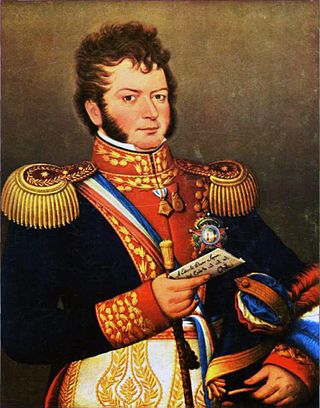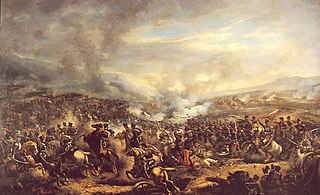Background
Prior to the fall of Talca in early March, Juan Mackenna had been positioned along the rata Itata river with a small division of patriot troops, whilst Bernardo O'Higgins had remained with the main body of the army in Concepción. After Talca fell to Royalist forces, however, Mackenna realised his lines of communication with O'Higgins were now cut and that he was isolated. Mackenna, the colonel of engineers on the patriot General Staff, formed a solid defensive position, building three mutually supporting bastions on local hills on the north bank of the north side of the Itata river near Membrillar. The Royalist commander, Gabino Gaínza, had sent a vanguard of 400 men into the hills of Quilo, south of the Itata river, to prevent the two patriot commanders from reuniting. This force had been defeated in the Battle of El Quilo on the 19 March, forcing Gaínza to attempt a different plan. Gaínza instead decided to attack Mackenna's forces immediately, before then turning on O'Higgins. Chillán sent additional reinforcements, and Gaínza then crossed the Itata to attack.

Bernardo O'Higgins Riquelme was a Chilean independence leader who freed Chile from Spanish rule in the Chilean War of Independence. He was a wealthy landowner of Basque-Spanish and Irish ancestry. Although he was the second Supreme Director of Chile (1817–1823), he is considered one of Chile's founding fathers, as he was the first holder of this title to head a fully independent Chilean state.

The Argentine War of Independence was a secessionist civil war fought from 1810 to 1818 by Argentine patriotic forces under Manuel Belgrano, Juan José Castelli, Martin Miguel de Guemes and José de San Martín against royalist forces loyal to the Spanish crown. On July 9, 1816, an assembly met in San Miguel de Tucumán, declaring independence with provisions for a national constitution.

The Battle of Cancha Rayada, was fought in Chile between South American patriots and Spanish royalists, during the Osorio's campaign in the South American wars of independence. The result was a defeat for the patriot forces, weeks later the patriots take their rematch at the Battle of Maipú.

The Chilean War of Independence was a military and political event that allowed the emancipation of Chile from the Spanish Monarchy, ending the colonial period and initiating the formation of an independent republic.

Grand Marshal Juan Gregorio de las Heras was an Argentine soldier who took part in the Spanish American wars of independence and was also a governor of the province of Buenos Aires.

Colonel Luis Florentino Juan Manuel Silvestre de los Dolores de la Carrera y Verdugo was a Chilean military officer who fought in the Chilean War of Independence. Together with his brothers José Miguel and Juan José, they were some of most important leaders of Chilean struggle for independence during the period of the Patria Vieja. The Carrera family is of Basque origin.

Gabino Crispín Gaínza Fernández de Medrano was a Spanish military officer, knight of the Order of St. John and prominent politician in Spain's American colonies. He supported and declared independence on 15 September 1821 in the Kingdom of Guatemala, becoming the first ruler or president "jefe político superior" of a united and independent Central America extending from Soconusco through Guatemala, El Salvador, Honduras, Nicaragua and Costa Rica; leader of the Consultive Junta of Guatemala until its dissolution on 21 February 1822. During the Latin American wars of independence, he initially fought on the royalist side in Chile, becoming Royal Governor of Chile. He then became the last Captain General in the Kingdom of Guatemala on behalf of the King of Spain. After independence and the annexation to Mexico, he became the 1st Captain General of Central America on behalf of the Emperor of Mexico.
Clemente de Lantaño Pino was a royalist military officer during the Chilean War of Independence. Later, during the Spanish reconquest, he changed sides and fought for independence against the royalist forces.

Spanish Reconquest or just Reconquest is the name of a period of Chilean history that started in 1814 with the royalist victory at the Battle of Rancagua and ended in 1817 with the patriot victory at the Battle of Chacabuco. During this period, the defenders of the Spanish Empire reestablished their dominion in Chile after said country had separated itself from the Spanish Crown, installed its First National Government Board in 1810—the first institution of self-government in Chile, created its First Congress National in 1811 and subsequently elected its first supreme director, Francisco de la Lastra, in 1814.
Treaty of Lircay was a truce treaty agreed between the Royalist and the Patriot forces during the Chilean War of Independence.

Events from the year 1814 in Chile
The Battle of Les Tres Acequias, fought during the Chilean War of Independence, occurred near San Bernardo on 26 August 1814. The confrontation occurred between the two factions of Carrera and Bernardo O'Higgins, resulting in a defeat for O'Higgins that would in turn lead on to the defeat of the nationalists by the royalist forces at the battle of Rancagua a month later.

The Battle of El Roble was fought on the Itata river, 17 October 1813, between the Chilean patriot general José Miguel Carrera and Spanish royalist forces under the command of Clemente Lantaño and Luis Urrejola. The surprise patriot victory at El Roble as a result of Bernardo O'Higgins' actions at the end of the day was to result in a change of patriot commander, and a severe split within the patriot movement.
The first battle of Cancha Rayada, sometimes termed the 'Disaster' or 'Surprise of Cancha Rayada', took place on 29 March 1814, during the War of Chilean Independence.
The Capture of Talca, occurred on 3 March 1814, during the War of Chilean Independence.
The battle of Quechereguas occurred on 8 April 1814, during the War of Chilean Independence.
The battle of San Carlos occurred on 15 May 1813, during the War of Chilean Independence.
Eraldon Manuel Barañao, was born in Tigre, Buenos Aires, Argentina but traveled to Chile in 1809, becoming a revolutionary supporter of Juan Martínez de Rozas and taking up commerce.
The Battle of El Quilo, fought during the Chilean War of Independence, occurred at el Quilo, on the southern side of the Itata river, on 19 March 1814.

New Fatherland was a period in the history of Chile that began with the victory of Ejército de los Andes in the Battle of Chacabuco on 12 February 1817 and ended with the resignation of Bernardo O'Higgins as Supreme Director in 1823.











